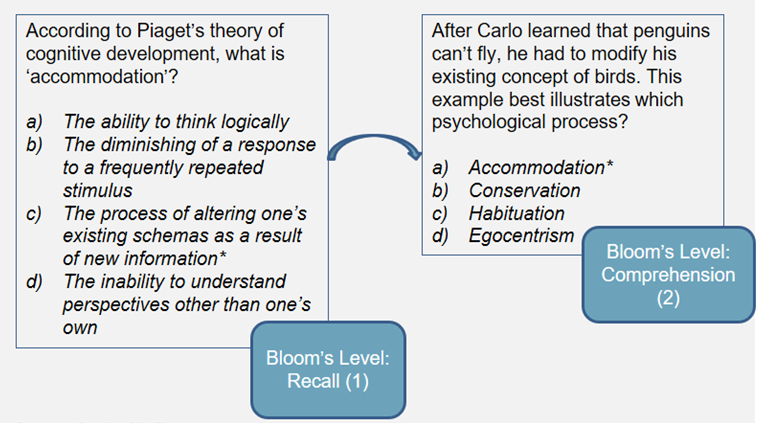Preparing content progressions for units, writing lesson plans, making them engaging and varied...
The Case for Multiple Choice
Multiple choice questions have become almost synonymous with high stakes testing, and thus with contrived, challenging, limiting, unfair, and high pressure situations.
On the other hand, when I tell my students their test is going to be multiple choice, they all let out a deep sigh of relief. To them, it has become synonymous with “easy”, probably because it can only test recognition, and not recall, so they can always fall back on guessing. But more on that later.
I want to argue that multiple choice has the potential to be so much more. Yes, bad multiple choice is worse than open response, but good multiple choice can actually be better than open response.
How could multiple choice be better?
- Infinitely faster to grade
I mean, it can be graded automatically, so it is literally instantaneous and thus infinitely faster to grade. Secondary teachers teach over 100 students, so assigning just one open response question takes about two hours to grade, minimum. And that’s without even giving personalized feedback. - Deeper insights into learning and misconceptions
You may be wondering, how can you get more insights from less information? Well, in order to act on patterns across students, re-teaching what is necessary, one must be able to look across answers and see patterns or themes. Even if you got an AI to sort the responses, you would ultimately need to boil down the richness of the data into a handful of categories in order to take any meaningful action at the instructional level. - Cuts right to the heart of the learning
If you have explored a concept with students, whether that’s through discussion or open response, you may have an idea of the different common misconceptions or traps students typically fall into. If you can make each answer choice represent each of these different common way of thinking about the problem, then your data is no longer only about “right or wrong”, it actually represents student thinking in a way that is actionable for the teacher. Walking through each way of thinking and how it does and does not relate to the way of thinking being taught in class is cutting right to the heart of the learning. It draws student attention to particular aspects of the concept, rather than trying to meet a whole class “where they’re at”. (In quotes because they’re all in different places!) and meandering around the conceptual landscape. In fact, this meandering can often confuse students who are not yet clear on the deep structure of the concept and may mistake superficial features for deep ones!
One pedagogy in which this is really apparent is Peer Instruction. For those who are not familiar, the gist is that the teacher puts a multiple choice question on the board, and students must convince each other of the correct answer. The idea is that a student who just learned the material may be able to explain it to a student who has not yet learned the material in a more accessible way than the teacher, who has to deal with the curse of knowledge. Because the alternate answers are shared with everyone and everyone can see that they are not alone in their confusion, student conversations can much more efficiently get to the reasoning behind understanding and thus untangle complex ideas.
Objection: They’re too easy
I am a little surprised my students keep rejoicing when I tell them their test is going to be multiple choice, since they find the questions extremely challenging. Just because it’s multiple choice, does NOT mean it can only test low levels of depth of knowledge! Recognition can be very applied and complex.
In this example, you can see a simple way to transform a question from recall to comprehension:

But questions can dig even deeper! Let’s look at this one:
Consider the question, “What is meant by the charge that utilitarianism is too demanding?” Now suppose the following answer is given: “Utilitarianism requires moral people to respond to important moral concerns such as helping the less fortunate, while allowing immoral people to pursue their careers, family lives, and personal projects.” What is wrong with this answer?
a. Nothing — that answer is correct.
b. It falsely describes what utilitarianism requires of moral people.
c. It falsely describes what utilitarianism allows of immoral people.
d. It relies on a false dichotomy between moral people and immoral people.
By scaffolding the structure of the answer, you can reach higher level cognitive reasoning that relies on applying existing knowledge for example to real life or new situations or to complex logical arguments.
In Summary
If you think multiple choice questions are limited, consider that they are simply a constraint. Creativity flourishes within constraints. Expand your imagination and use multiple choice wisely. Did I mention it takes zero time to grade?
If we can take multiple choice out of the corner its been boxed into, maybe it can stop backing us into corners too.
Sources:
Assessing Higher-Order Outcomes using Multiple-Choice Questions. University of Guelph. Retrieved April 14, 2023 from https://otl.uoguelph.ca/teaching-learning-resources/assessment-student-learning/assessing-higher-order-outcomes-using#:~:text=Although%20many%20MCQs%20are%20recall,such%20as%20analysis%20and%20synthesis.
Brame, C. (2013) Writing good multiple choice test questions. Retrieved April 14, 2023 from https://cft.vanderbilt.edu/guides-sub-pages/writing-good-multiple-choice-test-questions/.


